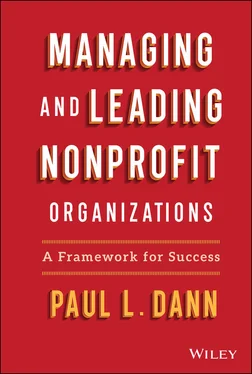Paul L. Dann - Managing and Leading Nonprofit Organizations
Здесь есть возможность читать онлайн «Paul L. Dann - Managing and Leading Nonprofit Organizations» — ознакомительный отрывок электронной книги совершенно бесплатно, а после прочтения отрывка купить полную версию. В некоторых случаях можно слушать аудио, скачать через торрент в формате fb2 и присутствует краткое содержание. Жанр: unrecognised, на английском языке. Описание произведения, (предисловие) а так же отзывы посетителей доступны на портале библиотеки ЛибКат.
- Название:Managing and Leading Nonprofit Organizations
- Автор:
- Жанр:
- Год:неизвестен
- ISBN:нет данных
- Рейтинг книги:4 / 5. Голосов: 1
-
Избранное:Добавить в избранное
- Отзывы:
-
Ваша оценка:
- 80
- 1
- 2
- 3
- 4
- 5
Managing and Leading Nonprofit Organizations: краткое содержание, описание и аннотация
Предлагаем к чтению аннотацию, описание, краткое содержание или предисловие (зависит от того, что написал сам автор книги «Managing and Leading Nonprofit Organizations»). Если вы не нашли необходимую информацию о книге — напишите в комментариях, мы постараемся отыскать её.
Managing and Leading Nonprofit Organizations: A Framework For Success
Managing and Leading Nonprofit Organizations: A Framework For Success
Managing and Leading Nonprofit Organizations — читать онлайн ознакомительный отрывок
Ниже представлен текст книги, разбитый по страницам. Система сохранения места последней прочитанной страницы, позволяет с удобством читать онлайн бесплатно книгу «Managing and Leading Nonprofit Organizations», без необходимости каждый раз заново искать на чём Вы остановились. Поставьте закладку, и сможете в любой момент перейти на страницу, на которой закончили чтение.
Интервал:
Закладка:
Eighth Practice Perspective: Hero Leadership versus Leading Heroes
The eighth and final perspective that I recommend you take on is one more antigravitational effort that possesses enough in the way of dynamic layers to argue that it too meets the definition of simplexity. As you develop your leadership practice for yourself, your team, and your organization, be sure to take a stance that moves against the cultural grain of creating the lone hero leader. Instead, be sure to create heroes at all levels of the organization. Resist the urge to become a hero leader and ensure that each of your team members feels celebrated as a hero for their contribution to the organization's mission and vision.
If you allow yourself to become the hero leader, then, by definition, you will exclude others from having the ability to share in leadership practice. When a team member feels that there is no room for them to play an important role there is a natural tendency for them to stand down rather than take on leadership behavior and engage in action that helps to buoy the work of the organization. Celebrate all the team member contributions and work to give credit away to those who are working on the team. By taking this stance you support the very fabric of your team's commitment and engagement. Grabbing the glory for oneself feels wonderful in the moment, but sadly squanders the value that can come from team members feeling that their contribution has made a difference. It is essential that each team member feels that they, too, can be a leader and have a role to play in helping to advance the organization.
By creating heroes across the organization, you also build your team's capacity to be engaged and responsive to the needs of the organization. Nonprofit organizations that enhance successful leadership practice across and within the organization are agencies that become resilient and find that they are well equipped to be successful in the face of any challenges that occur.
Each of the eight practice perspectives can help you to develop your own efficacy as a leader. In the Appendix of this book, you will find a tool for conducting a self‐assessment of your abilities in each of the practice perspectives. The tool, in addition to helping you conduct a self‐assessment, also makes it possible for you to thoughtfully develop strategies to advance your scoring and ultimately your capabilities in each of the areas. Once you have gone through and scored yourself, take some time to identify specific steps that you will take to heighten your skills within each practice perspective. I recommend using your assessment as a working document and revisiting it from time to time to see how your practice perspectives are developing.
Another option for the use of this tool is to work with your team to have each team member complete an assessment. Once everyone has completed their assessment, take time to share as a group where each individual scores. What strengths do they have and where are the areas for growth? What are some of the strategies that everyone has come up with to move their practice perspectives forward? Often working together as a team on practice perspectives can help leverage your group's ability to exercise collective leadership skills. As a group you will develop a greater understanding of everyone's strengths, how they contribute effectively to the team, and where the areas for growth lie. Most teams quickly realize that they can complement each other and help to support their colleagues as they work to advance their leadership practice.
Strategies for Developing Leadership Practice
Now that we have looked at the eight leadership practice perspectives, our attention turns to some specific strategies for developing leadership practice. The strategies explored in this section of Chapter 2 are not intended to be exhaustive, but rather representative of tried‐and‐true ways to help develop your leadership practice. As with the earlier discourse you should consider each of these strategies as dynamic and as such consider that they apply to your personal leadership practice as well as your team's and your organization's leadership capacity.
Opportunity and Engagement
My own research in leadership development discussed in depth in Chapter 5shows that leadership skills and abilities will grow when opportunities are present to take on leadership responsibilities. Actively pursuing opportunities for developing your leadership practice aligns closely with your engagement with the organization and taken together they can be a powerful source for leadership development. Given this, use your practice perspectives to be on the hunt for opportunities to advance your leadership skills. On any given day, if you avail yourself, you will find there are multiple instances that can serve as an opportunity to develop your leadership skills. This can be something as simple as volunteering to serve on a committee, being willing to take on a specific responsibility for the team such as organizing an event, agreeing to take minutes, offering to pursue a fundraiser, or any number of activities, including representing the organization with external stakeholders.
If you are willing to step up and take it on, then you will quickly see that your fellow team members—including your supervisors—no matter the level, will begin to gravitate toward you and think of you as a go‐to person for activities that can lend themselves to additional leadership responsibility and, more important, your capacity to develop as a leader. Actively pursuing opportunities to develop your leadership skills will provide you with invaluable experience so that you can practice and refine your leadership skills.
For example, I can think of a newly minted entry‐level leader within a nonprofit multiservice agency who was seen volunteering for any number of activities. First, he offered to keep track of his program's monthly vehicle safety checklist. From there his director asked him if he wanted to serve as the safety coordinator, representing his program for the agency's corporate safety committee. Soon the committee discovered that he had graphic design skills and he began churning out a wonderful safety committee newsletter—while along the way being promoted to assistant director. It was clear that he not only possessed leadership skills but was actively refining them while building his reputation as a go‐to person. He is on a journey, and it will be interesting to see where the journey takes him.
Pursuing opportunity and working to be fully engaged not only benefits the individual, but also the entire team. In my formal leadership role, I know that creating multiple opportunities for employees to be engaged and to develop their own leadership capabilities not only helps them learn and grow but also benefits the organization. An organization that has multiple opportunities for employees to develop and express leadership is an organization that is vibrant and dynamic.
Nonprofit agencies, when organized well, can help to ensure that there are multiple opportunities for employees to become engaged in developing their leadership capabilities. Clearly there are the traditional notions of leadership training programs which in and of themselves have a positive impact, and then there are a multitude of other strategies that can help to build your organization's culture of leadership development. As mentioned, committees are an easy way to help people develop their leadership capacity. In particular, ad hoc committees that are working to address a particular project can be useful as a strategy to connect employees to a level of leadership practice. There are other structural strategies as well. For example, how the organization pursues its continuous quality improvement (CQI) practices can help or hinder the development of leadership practice. Is the effort pursued by a single department or employee or is there cross‐organization participation for employees at various levels within the agency? Providing opportunities for various parts of the organization to work together on functions beyond the individual's day‐to‐day responsibilities makes it possible for individuals to step up and take responsibility that not only benefits the organization but also helps the employee build their own leadership practice.
Читать дальшеИнтервал:
Закладка:
Похожие книги на «Managing and Leading Nonprofit Organizations»
Представляем Вашему вниманию похожие книги на «Managing and Leading Nonprofit Organizations» списком для выбора. Мы отобрали схожую по названию и смыслу литературу в надежде предоставить читателям больше вариантов отыскать новые, интересные, ещё непрочитанные произведения.
Обсуждение, отзывы о книге «Managing and Leading Nonprofit Organizations» и просто собственные мнения читателей. Оставьте ваши комментарии, напишите, что Вы думаете о произведении, его смысле или главных героях. Укажите что конкретно понравилось, а что нет, и почему Вы так считаете.











